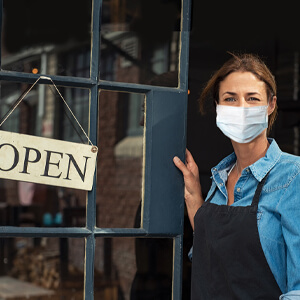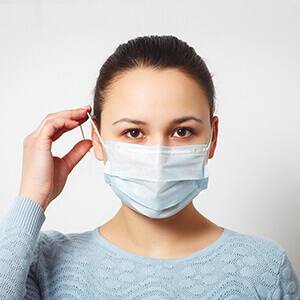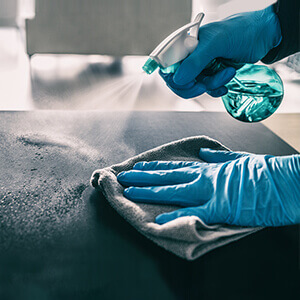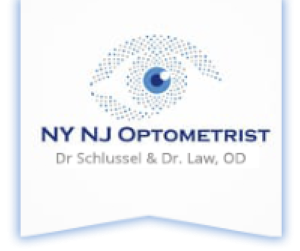.
.

Dr. Alan Schlussel & Associates Re-Opening & Offering Appointments!
During the COVID-19 pandemic, the safety and well-being of our patients, staff and doctors is our first priority. Our team will continue to go above and beyond the expectations for optometry practices so that everyone who enters our practice will feel safe. These measures include, but are not limited to:


We All Need To Wear Masks

Practice Social Distancing

We Dissinfect Well & Often

We Offer Curbside Delivery

Call Us With Any Questions
COVID-19 Policy for Optometric Practices
Prior to and after patient care
- We will make sure that staff are symptom free each day.
- Have a non-contact thermometer available to assess temperature, as needed. (NOTE: Temperature alone does not assess or exclude disease.) The CDC defines a fever as a temperature at or above 100.4°F.
- Ask if they are coughing.
- Ask if they have shortness of breath.
- If staff report or appear ill, recommend that they contact their primary care
physician. - Advise staff to NOT travel to the emergency room if they are at risk for
COVID-19.
- Clean all equipment with best available disinfectant (Benefect or alcohol solutions with
at least 70% alcohol). - Have staff thoroughly wash hands for at least 20 seconds when they arrive, before and
after each patient, before eating and after using the bathroom. - Instruct staff to wash hands upon entering or use an alcohol-based hand sanitizer.
The CDC recommends the use of alcohol-based hand sanitizers with greater than
60% ethanol or 70% isopropanol as the preferred form of hand hygiene. - Staff should use one phone and one computer and maintain social distancing between
themselves. Should they need to change phones or computers, have them disinfect in
between use
Clinic/Exam Rooms:
- Clean exam room/patient rooms with best disinfectant (see above) in between each patient (with disposable gloves).
- Utilize as much disposable equipment as possible.
- Utilize a slit lamp “breath” shield/barrier.
Overall Recommendations & Procedures:
- Doctors and staff will wash hands as frequently and thoroughly as possible and utilize hand sanitizer, when not wearing disposable gloves.
- Dry hands with disposable paper towels as opposed to air dryer machines or cloth towels.
- Utilize a non-contact tonometer
- Buy multiple spray bottles for office disinfectant.
- Create an emergency contact list of staff members for everyone to have at home.
- Keep a daily log of patients, phone numbers, and emails on the pen to paper. Have a staff member bring home every night just in case the office needs to close due to exposure or if patients need to be contacted due to exposure.
- Utilizing remote/Telemedicine care options for patients when possible.
- Caring for your patients during difficult times will always be remembered. Here are a few best practice tips:
- Call your patients after hours to check up on them if you may be concerned about their ocular or systemic health. It is times like these that can also build a practice.
- Consider making staff available to go outside to pre-screen or answer patient questions, or drop off contact lenses or eyeglasses, if necessary, for anyone who feels they are at risk coming inside.
During Patient Care
- Post a notice on your office door advising patients/staff not to enter if they are ill, were exposed to someone with the coronavirus, or have recently traveled to one of the affected countries.
- Assess if the patient is ill, has been exposed to someone who is ill, or has traveled to one of the countries with active coronavirus as soon as they arrive. If they are at risk, isolate them and call your local health department for instructions.
- Instruct patients to call ahead if they feel sick, have red eyes (conjunctivitis) or have any concerns.
- Instruct patients to limit the number of people that accompany them to 1 person
- Offer to reschedule non-emergent patients 70 years and older, patients with comorbidities or pre-existing conditions with decreased immunity.
- Consider setting aside blocks of time (e.g., the first two office operating hours)
for older/at risk patients to better protect their health and safety.
- Consider setting aside blocks of time (e.g., the first two office operating hours)
- Ask patients to come to the office wearing a face mask, if available, or we will provide one.
- Have a non-contact thermometer available to assess temperature, as needed. (NOTE: temperature alone does not assess or exclude disease.)
- The CDC defines a fever as a temperature at or above 100.4°F.
- Limit the number of patients in the waiting room to 1 person.
- Remove chairs/space out chairs (social distancing).
- If sufficient room is not available, ask patients to wait in the lobby until the doctor is ready. If the patient has a cell phone, text the patient to come in when ready. If not, ask the staff to alert them to come into the office.
- Utilize Personal Protective Equipment, as available and in accordance with recommendations from the CDC (eg Mask & disposable gloves at a minimum).
- Maintain and practice social distancing as much as possible so as not to physically contact the patient outside of clinical necessity, including no handshakes for now.
- Instruct patients to use alcohol-based hand sanitizer. CDC recommends the use of alcohol-based hand sanitizers with greater than 60% ethanol or 70% isopropanol as the preferred form of hand hygiene in health care settings, based upon greater access to hand sanitizer.
